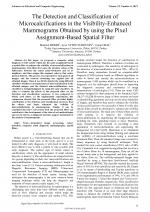| 4/2019 - 9 |
The Detection and Classification of Microcalcifications in the Visibility-Enhanced Mammograms Obtained by using the Pixel Assignment-Based Spatial FilterHEKIM, M. |
| Extra paper information in |
| Click to see author's profile in |
| Download PDF |
Author keywords
biomedical image processing, cancer detection, computer aided diagnosis, mammography, spatial filters
References keywords
mammograms(13), detection(12), microcalcifications(9), microcalcification(8), image(8), system(7), digital(7), breast(7), analysis(7), segmentation(6)
Blue keywords are present in both the references section and the paper title.
About this article
Date of Publication: 2019-11-30
Volume 19, Issue 4, Year 2019, On page(s): 73 - 82
ISSN: 1582-7445, e-ISSN: 1844-7600
Digital Object Identifier: 10.4316/AECE.2019.04009
Web of Science Accession Number: 000500274700008
SCOPUS ID: 85077265775
Abstract
In this paper, we proposed a computer aided diagnosis (CAD) system which has the pixel assignment-based a spatial filter to enhance the visibility of microcalcifications in mammograms. This filter first sums the absolute values of the differences between the center pixel-of-interest and its 8-neighbors, and then assigns this summed value to that center pixel-of-interest. This process was repeated for each pixel of all images, and the contrast stretching was applied into all obtained images. Then, it was firstly detected by using different classifiers whether is absent/present of microcalcification in the obtained images, and the detected microcalcifications were classified as benign/malignant by using the same classifiers. In order to evaluate the effects of the proposed filter on the detection and classification successes, it was compared to widely used filters. In the implemented experiments, this comparison showed that the proposed filter provided higher contribution to the detection and classification successes than the others, and hence enhanced the visibility of microcalcifications in mammograms. Finally, it can be concluded that the CAD system with the proposed filter can contribute to the development of the state-of-art methodologies and can be used as a diagnostic decision support mechanism in the analysis of mammograms. |
| References | | | Cited By |
Web of Science® Times Cited: 4 [View]
View record in Web of Science® [View]
View Related Records® [View]
Updated today
SCOPUS® Times Cited: 4
View record in SCOPUS® [Free preview]
View citations in SCOPUS® [Free preview]
[1] Hybrid Feature Mammogram Analysis: Detecting and Localizing Microcalcifications Combining Gabor, Prewitt, GLCM Features, and Top Hat Filtering Enhanced with CNN Architecture, Hernández-Vázquez, Miguel Alejandro, Hernández-Rodríguez, Yazmín Mariela, Cortes-Rojas, Fausto David, Bayareh-Mancilla, Rafael, Cigarroa-Mayorga, Oscar Eduardo, Diagnostics, ISSN 2075-4418, Issue 15, Volume 14, 2024.
Digital Object Identifier: 10.3390/diagnostics14151691 [CrossRef]
[2] Classification of Mammographic ROI for Microcalcification Detection Using Multifractal Approach, Kermouni Serradj, Nadia, Messadi, Mahammed, Lazzouni, Sihem, Journal of Digital Imaging, ISSN 0897-1889, Issue 6, Volume 35, 2022.
Digital Object Identifier: 10.1007/s10278-022-00677-w [CrossRef]
[3] Detection and classification of microcalcifications in mammograms images using difference filter and Yolov4 deep learning model, Yurdusev, Ayşe Aydın, Adem, Kemal, Hekim, Mahmut, Biomedical Signal Processing and Control, ISSN 1746-8094, Issue , 2023.
Digital Object Identifier: 10.1016/j.bspc.2022.104360 [CrossRef]
[4] Comparison of Classification Algorithms for Detecting Patient Posture in Expandable Tumor Prostheses, KOCAOGLU, S., AKDOGAN, E., Advances in Electrical and Computer Engineering, ISSN 1582-7445, Issue 2, Volume 20, 2020.
Digital Object Identifier: 10.4316/AECE.2020.02015 [CrossRef] [Full text]
Disclaimer: All information displayed above was retrieved by using remote connections to respective databases. For the best user experience, we update all data by using background processes, and use caches in order to reduce the load on the servers we retrieve the information from. As we have no control on the availability of the database servers and sometimes the Internet connectivity may be affected, we do not guarantee the information is correct or complete. For the most accurate data, please always consult the database sites directly. Some external links require authentication or an institutional subscription.
Web of Science® is a registered trademark of Clarivate Analytics, Scopus® is a registered trademark of Elsevier B.V., other product names, company names, brand names, trademarks and logos are the property of their respective owners.
Faculty of Electrical Engineering and Computer Science
Stefan cel Mare University of Suceava, Romania
All rights reserved: Advances in Electrical and Computer Engineering is a registered trademark of the Stefan cel Mare University of Suceava. No part of this publication may be reproduced, stored in a retrieval system, photocopied, recorded or archived, without the written permission from the Editor. When authors submit their papers for publication, they agree that the copyright for their article be transferred to the Faculty of Electrical Engineering and Computer Science, Stefan cel Mare University of Suceava, Romania, if and only if the articles are accepted for publication. The copyright covers the exclusive rights to reproduce and distribute the article, including reprints and translations.
Permission for other use: The copyright owner's consent does not extend to copying for general distribution, for promotion, for creating new works, or for resale. Specific written permission must be obtained from the Editor for such copying. Direct linking to files hosted on this website is strictly prohibited.
Disclaimer: Whilst every effort is made by the publishers and editorial board to see that no inaccurate or misleading data, opinions or statements appear in this journal, they wish to make it clear that all information and opinions formulated in the articles, as well as linguistic accuracy, are the sole responsibility of the author.



